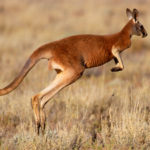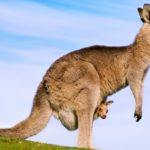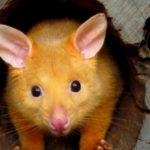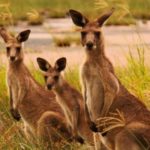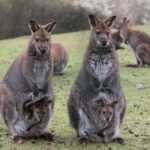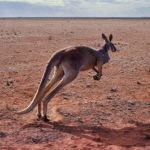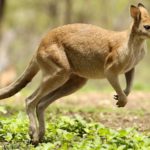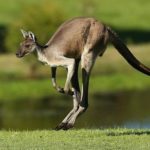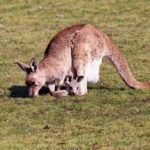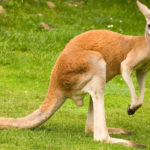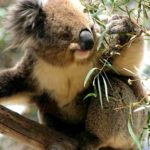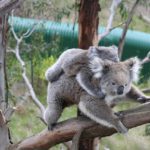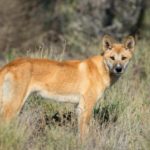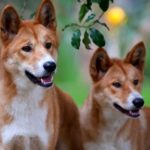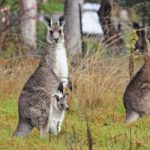Quokka
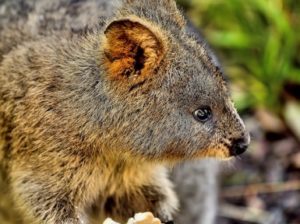 Quokka or otherwise settoniks, belongs to the kangaroo family. This is a small animal the size of a large domestic cat. Externally, the Quokka resembles a small kangaroo with a small tail or a large rodent. That is why the first Australian settlers took these animals for rats. Knocks, like large kangaroos, move irregularly on the ground. They have strong long hind legs, allowing to make jumps up to two meters long.
Quokka or otherwise settoniks, belongs to the kangaroo family. This is a small animal the size of a large domestic cat. Externally, the Quokka resembles a small kangaroo with a small tail or a large rodent. That is why the first Australian settlers took these animals for rats. Knocks, like large kangaroos, move irregularly on the ground. They have strong long hind legs, allowing to make jumps up to two meters long.
Australian marsupial animals are a separate class of animals, most of which are kangaroos, which have about fifty varieties, the more famous of which are: big red kangaroos, gray forest kangaroos, mountain kangaroos vallare, tree kangaroos wallabies, kangaroo rats and small short-tailed kangaroos – quokku . That’s about this very Kvokke and will be discussed in this review.
Khokka-animal-Description-and-way-life-Kvokki-1
It turned out that when the Dutch arrived in Australia at the beginning of the nineteenth century, under the leadership of Samuel Volkersen, visited an island lying not far from the coast, they saw a lot of these animals on it and took them for rats, so they called this island “Rottnest”, which is translated from Dutch like a rat’s nest. Although some time later they became convinced that there were indeed rats in Australia, but they have nothing to do with the Quokk, the name of the island remains to this day. And the differences between forts and rats are quite noticeable. Judge for yourself, here on the photo is a marsupial angry angry rat.
But the photo is quite sweet, funny and completely harmless Quokk. He even has the expression of his face looking like he smiles good-naturedly.
Probably just because of this, or as they are called by their quokka – “quokka”, they live in places where they are not in danger. Their habitats are small islands Bald, Rottnest, Penguin, as well as relatively isolated from the main continent places in Albany, a region of Western Australia.
There are no wild cats, foxes and Dingo dogs, and people, knowing their harmlessness, don’t touch them. It is not surprising that these little animals can easily be found in small towns or villages where they are not afraid of anything.
Quokka look pretty nice. Their body length is a little more than half a meter, and they weigh on average 4-5 kg. The fur is short and thick gray, brown or brown, the belly is lighter in color with a reddish tinge. The ears are small, but wide, short and round, quite a bit protruding from the fur. The tail is covered with sparse, stiff hairs, it is not surprising that, because of this peculiarity, they were first mistaken for giant rats capable of attacking people. But this is absolutely not the case. Knocks are completely herbivores. They have 32 teeth, but no canines. They do not need them, because they eat grass and any other plant food. They live in places with dense vegetation, where there is a lot of food for them. It prefers marshland with shrubs and trees, in the shade of which you can hide from the heat of the day. They are nocturnal, go out in search of food at dusk, moving along the well-trodden paths in the foliage. They feed on young shoots, grass, leaves.
The front short legs are almost like human hands. They can tear off the leaves, fruits and bring them to the mouth, well, just like real kangaroos.
In terms of breeding Quokka lead a rather peculiar way of life. Usually males and females live by themselves. And communicate only at the time of mating. Then the female somewhere in a month gives birth to a cub. He is very small and not quite developed, but he has a congenital instinct, thanks to which this little girl weighing just over one gram, clinging to her wool with strong forelegs, crawls into her mother’s abdominal bag where she continues to develop over 5 months, feeding on her mother’s milk. At the same time, there is one surprising fact not found in any other animal. The fact is that if the calf does not survive for some reason, then the female can give birth to the second in a month, and the pairing is completely unnecessary for this, as the underdeveloped “spare” embryo survived with developmental delay. That is so amazing nature took care of the conservation of this species.




